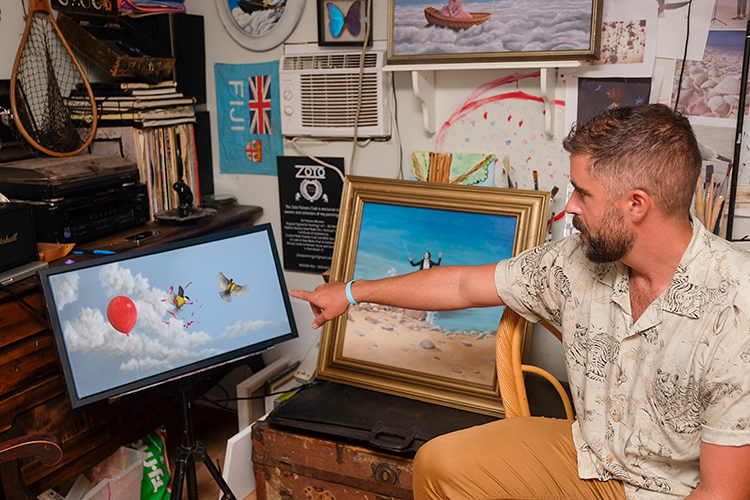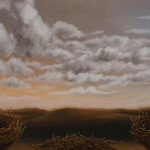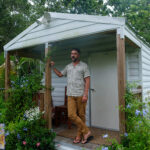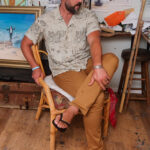
Adam Conard’s first foray into painting, at age 12, barely raised his father’s eyebrows, despite that his painting wasn’t on paper, or even on canvas. Conard had decided to paint the inside walls of their house in Jackson Hole, Wyoming, and had finished by the time his father came home at the end of the day.
His father, whose child rearing philosophy was to give his children a lot of freedom, simply responded with, “Hmmm, what does this mean?”
Nicknamed “Zoto” by his dad, the name means freedom to Conard, who signs his paintings with Zoto and named his website ZOTOArt.com.
His father’s patience was again tested with Conard’s second painting, which involved ripping up his bedroom carpet to paint a large mural on the floor, which he periodically added to over the years.
At age 16, Conard says his uncle, Michael Ciasullo, a well-known Austin, Texas, artist passed away “somewhat abruptly.” Having been aware of Conard’s habit of frequently sketching, Ciasullo left him a box filled with his paint brushes and a note: “Adam, Keep painting. Michael.”
The gift coincided with a basketball accident that resulted in a broken back. His upper body was encased in an immobile cast for 18 months, and doctors said he’d never be able to play basketball again.
To release pent-up energy, he began painting with the brushes, although with limited movement it took six months to finish his first painting. He eventually deified the odds through physical therapy and was able to play basketball again, but his affinity for art continued.
As luck would have it, his high school art teacher, Floyd Thompson, was also a renowned artist.
“I still talk with him frequently and he continues to inspire me. He was a passionate and amazing art teacher who put his students first. We never knew [while in school] that he was a well-known artist.”
Conard and his family arrived in Vero Beach during the first winter of COVID and that spring made plans to move here permanently from Colorado, where they had been living.
“If we were going to be shut down, it might as well be in some place warm. It was a blessing. I had time to paint, and time for my family. I could never go back to working in an office again,” Conard explains.
Additionally, he says he appreciates life and the time we have on earth to celebrate it, adding, “I’ve lost a higher number of people than anyone I know.”
Conard is often inspired by their 8-year-old daughter – to be joyful and to do things he wouldn’t otherwise do as an adult. Just like his own father, Conard wasn’t fazed when she painted the walls of his current studio, saying, “It is wonderful to let the artistic desire flow.”
Indeed, she creates a few pieces of art each day, starting on her own with no coaxing from her parents.
“It brings whimsy in my art. I really want that sense of emotion in my paintings, that sense of life and being alive. It’s so precious. To capture this life, it’s like a race to do as many paintings as I can while I’m here.”
Conard paints one or two paintings each week, working five to six hours at a stretch, often well into the night.
“I have a frequent and vivid dream life,” he says. “I always look for some deeper symbolism [in dreams], and the images and symbolism often make their way onto a canvas.”
His painting “Sea Shell Sonata” resulted after dreaming of a conductor directing shells, which make music as water rushes over them and retreats. Remarkably, the painting delivers that sense of music.
His painting [out of darkness] “Into the Light” is from a continuing dream where he floats a few feet off the ground to observe, then back to earth and up again. The painting pictures birds, a red balloon, and a boat that is floating on clouds.
“The bird symbolizes anybody trapped in darkness. The balloon bursts, and the bird flies off to freedom, finding more gratitude, positivity and light,” he explains.
In a black and white drawing, a man holds an open umbrella over his head, but it is only raining under the umbrella and onto the man. “He’s creating his own storm.”
Although Conard tries to paint just one piece at a time, his brain is frequently moving on to the next one.
“I get excited to the point that I can’t sleep. I have to force myself to finish a painting before I move on.”
The paintings’ titles are also important to Conard, such as with “Whole Again,” which he says represents a message of hope and new life.
In that one, a bird’s nest is depicted to the left. Mid painting, the nest is broken apart, but a new nest, stronger and better than the old one, with a beautiful egg in it, lies on the right.
While Conard’s older works had a drip effect, or were photo realistic, his newer ones are more impressionistic. The background composition is not too detailed, whereas the subject matter pops out in realism.
“The dichotomy of spontaneous background and detailed subject is my go-to style,” he says, adding that his artistic styles evolved innately.
Although he was a student of classical artists, who painstakingly detailed their work, he describes his own style as classic surrealist.
“Surrealism isn’t a popular style, but it’s the only way I can capture the realness,” he says.
“My early paintings could be mistaken for photographs, but I was looking for more freedom. I blended them to capture in a surreal way, but not so surreal that you can’t believe it, a wholesome, real earth.”
He also continues to be painstakingly dedicated to detail, wanting proportions to be believable.
“I often paint a real sky, one that I took a picture of. [The images] are all real-life things, portrayed in a surreal way. Without the refinement, the viewer might not focus and get my message,” says Conard.
“I wanted to be different. My quest is to rebel against the status quo, and I think my art shows that as well.”
His favorite paints are the highly pigmented, hand-made oils made by Williamsburg Oils.
In fact, his immense appreciation for their product resulted in his being named a key influencer in the company’s artist program. No money is exchanged, but he judges new colors, and receives free paint.
A collector of vintage clothes, cars, hats and instruments, Conard enjoys listening to records from the 1940’s and 1950’s while painting in his studio.
“The old blues records; each song tells a story of the time period. The resilience of the people is so inspiring,” he explains.
Conard believes he has found what he calls true wealth and inspiration in Vero Beach, noting: “True wealth is not in money, but in values; time with family and respect for other people.”
Active in the Vero Beach Art Club, Conard will co-chair the 2023 VBAC Under the Oaks Fine Arts and Crafts Show, and recently became the administrator of the Cultural Council’s Art in Public Places project.
Photos provided












